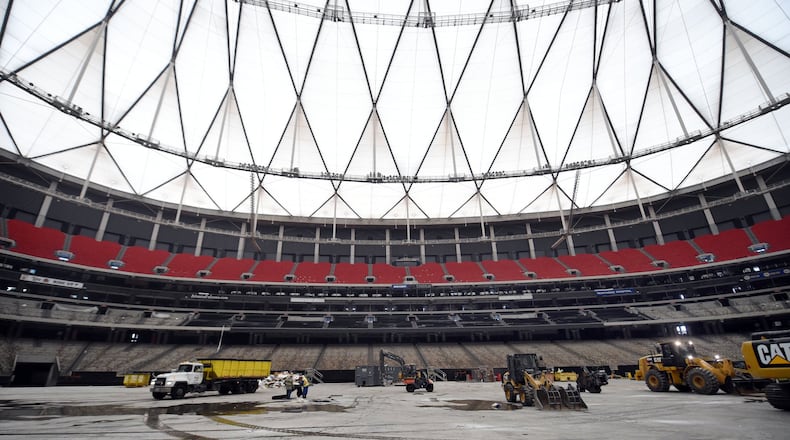As workers prepare the shiny new Mercedes-Benz Stadium for its opening late this month, a much less glamorous task is under way next door.
Inside the Georgia Dome, demolition contractors are dismantling and emptying the Falcons’ former home, prepping the 25-year-old building for implosion in November.
The Dome looks jarringly different than when fans last filled it. Already, it is a shell of its former self.
Tens of thousands of seats have been removed. Some windows have been knocked out, some interior walls torn down. One of the main video boards has been dismantled. Utilities have been disconnected. Piles of debris seem out of place in a building long praised for its well-kept condition.
Outside, a security fence with a padlocked gate surrounds a stadium that welcomed 37.6 million people to 1,456 events over the past quarter-century.
Before Patrick White, the Georgia Dome’s building-services manager for 20 years, joined a reporter on a visit inside the building last week, he was warned by a colleague that it would be a difficult sight to see.
And it was.
“It’s like tearing down my house that I love so much,” White said as he entered the building. “Now it’s gone, or it’s in the process of going, and just looking through the door, man, I can already feel my eyes starting to water.”
When you walk through a portal onto what used to be the playing surface — the surface on which two Super Bowls, three Final Fours, Olympic basketball and gymnastics, 199 regular-season Falcons games, seven Falcons playoff games and 152 college football games were played — the scene is disconcerting.
The floor on which Michael Vick, Michael Jordan, Kerri Strug, Matt Ryan and countless other stars performed has been stripped of the artificial turf and other playing surfaces that adorned it all these years. It now contains demolition equipment, Dumpsters and portable toilets.
Surrounding the floor, the lower and middle seating bowls are expanses of scarred concrete, the red and black seats mostly gone.
“I was in there on utility-disconnect day and shed a tear because it was sad to see it,” said Adam Straight, senior director of project and program management for the Georgia World Congress Center Authority, which operated the Dome. “It is rough when you get in there.”
On Aug. 23, 1992, the Georgia Dome opened to rave reviews with a Falcons exhibition game. A not-easily-impressed columnist wrote that day: "The Georgia Dome is a wonder, a marvel, a sensory delight. It will be a source of pride for this city for the next 30, 40, 50 years."
Twenty-five years and three days after the Dome’s debut, Mercedes-Benz Stadium is scheduled to open, also with a Falcons exhibition game. It is 400,000 square feet larger than the Dome (2 million vs. 1.6 million) and cost about seven times as much to build ($1.5 billion vs. $214 million). It will be operated by the Falcons organization.
The Georgia Dome hosted its final event March 5 — a Monster Jam trucks show — and the original plan was for the building to be imploded this summer. But Mercedes-Benz Stadium's three construction delays, caused by its problematic roof, prompted GWCCA and Falcons officials to pause preparations for implosion for several months in the spring to keep the Dome standing a while longer as insurance against further delays.
When officials were satisfied in June that the new stadium would meet its thrice-revised opening date of Aug. 26, work resumed on deconstructing the Dome. Much of the interior will be demolished before implosion takes down the exterior walls and roof.
Schneider Industries, hired to liquidate the contents of the building, held a sealed-bids sale of equipment, furniture and fixtures that weren’t reusable on the Congress Center campus.
Some seats were sold to fans for $599 per pair. Others were sold in bulk. Others, still in place in the upper deck, will be shredded.
The chillers and boilers have been removed and the suites gutted. Part of one video board was sold, while no market has been found for others because of their dated technology. The Falcons and the GWCCA completed in mid-July the move-out of gear they wanted to keep.
The concrete in the lower seating bowl is scheduled for demolition this month. The loading docks are being torn out. Copper, plastic and other materials are being recycled.
Implosion is scheduled for Nov. 20, after which the site will be graded and a retaining wall constructed. A park-like green space, a grass parking lot and a hotel are planned for the 13-acre site.
Speaking to the GWCCA board recently, Steve Cannon, chief executive of Falcons parent company AMB Group, delivered an enthusiastic report on the new stadium before adding a brief update on what’s happening in the team’s former home. His presentation included two slides that showed the Dome in its current state.
“I don’t even like showing these pictures because they’re kind of sad, based on my … memory of us beating Green Bay (Jan. 22 for the NFC championship) in one of the most electric moments in Georgia Dome history,” Cannon said.
About all that remains of value in the Dome are the memories, and White has more of those than most.
As building-services manager, he was in charge of the multipurpose stadium’s frequent conversion from one event to another, as well as overseeing the housekeeping and landscaping departments. He stayed overnight in the building on many occasions, especially when it had back-to-back events. He fondly remembers the big games, the challenges, the people.
He can laugh now about things that weren’t funny at the time, like when his bosses implored him years ago to do something about the “hazy spots” on the artificial turf that were noticeable on TV. He applied a product that made the field look beautiful. Problem is, it also made the field treacherously slippery for the players. He had it removed after one Falcons game — luckily, no injuries — and “the hazy look didn’t matter to anybody anymore,” he recalled.
But mostly, White remembers the dedication of a staff that took pride in making the Dome the best it could be operationally and physically, event after event.
“To be able to have a 70,000 crowd leave between 11 and 11:30 at night and have that building cleaned up and ready to go in every aspect by 6:30, 7:00 the next morning was an amazing thing,” he said. “There was a lot of dedication from the staff to make sure it was the best stadium on the planet.”
Last week’s visit may have been White’s last inside the Georgia Dome. He retired from the GWCCA on Monday after 25 years with the state agency, including 20 with the Dome. But he plans to be nearby when the Dome meets its ultimate fate at 7:30 a.m. Nov. 20.
“I will watch the implosion,” he said. “I want to come down and watch. It’s going to be rough, but I just want to see it.”
About the Author



